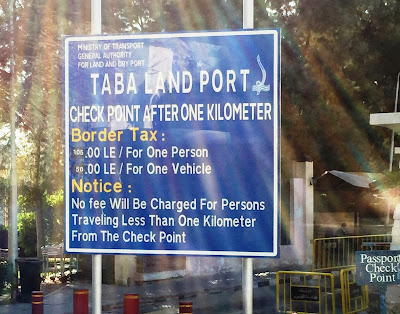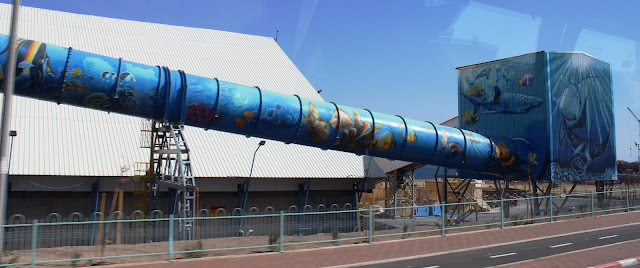In his book Walking the Bible, Bruce Feiler notes:
The distance between Jerusalem and Cairo is almost impossible to measure. By foot it should take about a month, by camel two weeks, by bus a day. But for most of history, such conventional means rarely worked. Abraham made it fairly easily, as did Mary and Joseph when they fled Bethlehem with the baby Jesus to escape the wrath of Herod. But Moses, going the other way, took forty years, and still fell short. Napoleon got bogged down in the dunes, as did the English army a century later. During the first thirty years of the Israeli state, the 250 miles from one city to the other was wider than any desert, and more impenetrable. Even the advent of air travel, which has reduced the trip to an hour, has done little to reduce the distance.
Sad but true. We were surprised to learn that we would not be flying from Israel to Egypt. We were told that there are not flights. Really? I did my own search on Travelocity and saw that there are indeed a few flights, but not any that are direct. A one-way ticket from Tel Aviv, Israel, to Aswan, Egypt, a distance by air of 570 miles, makes a huge detour to Istanbul, Turkey, and costs $1850; a round-trip ticket is $2,800. WOW. Granted, Aswan has a pretty small airport, so I checked to see if there are flights from Tel Aviv to the much larger Cairo airport. That flight costs much less--$480 round-trip--but that's a distance of only 250 air miles. Oh wait. It stops in Amman, Jordan. So I guess the truth is that there really are no flights from Israel to Egypt, at least none available through Travelocity. You have to fly somewhere else, then fly to Egypt. Crazy.

Instead, we had a great drive through the lonely and forbidding Negev Desert to a border crossing near Eilat, which gave us exposure to an area of Israel--and Egypt--that we would not have otherwise seen. We crossed the border into the resort town of Taba, then flew out the next afternoon from the tiny Taba airport to the tiny Aswan airport. It worked, and the itinerary meant we got to see the beautiful Gulf of Aqaba inlet of the Red Sea, thereby completing the Israeli Sea Triumvirate of Med, Dead, and Red. (Unfortunately "Galilee" doesn't rhyme to make it a foursome.)
We started off driving alongside the Dead Sea:
We passed several salt processing plants:Too bad there isn't something like this on the shores of the Great Salt Lake:
As a side note, I wanted to buy some Dead Sea cosmetics on this trip, and we saw them in many places, but they were very expensive. Imagine my surprise when I came home and found the same brand that we saw in Israel and Jordan for sale in my local TJ Maxx for a third of the price:
Anyway, after we left the Dead Sea behind us, it was miles and miles of the Negev Desert:
 In Walking the Bible, Feiler writes:
In Walking the Bible, Feiler writes:The Negev, which means "dry south country," is the Siberia of Israel, a region of vast emptiness and barren beauty that has both fascinated and repelled observers since the days of the Bible. Shaped like an arrowhead pointing south, the Negev is bordered by Jordan to the east, the Sinai to the west, and the vast undeveloped center of Israel to the north. Today its four thousand square miles represent 60 percent of the landmass of the State of Israel but hold only 6 percent of the population. Far from isolated, though, the Negev is actually part of a broad belt of deserts, including the Sahara, the Sinai, and the Arabian, that girds much of the world.
These four deserts comprise The Original Bible Belt, according to Feiler.
We finally reached an oasis that looked almost like Indio in Southern California, right down to the orchards of date palms and the backdrop of low mountains:
We stopped at a little store for a bathroom break, and what do you know--they had some pretty good gelato! We had tried gelato several times in Israel without finding anything really noteworthy, but they must have happy cows in southern Israel because this was good gelato:
 |
| Sitting on a happy cow in the Land of Milk and Honey |
Then we had our first glimpse of the jewel-toned Gulf of Aqaba, the eastern finger of the Red Sea:
With the ever-present tension between Israel and Egypt, we weren't sure what to expect at the border, but it was a relatively easy crossing with egress and ingress stations:This station is the only border crossing between Israel and Egypt that currently handles tourists.

We had to show our passports four or five times, including one time after we had reboarded the bus on the Egypt side of the border.

However, we seemed to be the only people crossing the border, so everything went pretty quickly. We weren't interrogated or patted down. Our tour company handled all the border taxes. We just showed our paperwork and went through.
Clearly, someone has told Egypt about "Kodak Moments":
As soon as we were across the border, we had our first sighting of a man wearing a galabia, an Egyptian robe that looks like a very long shirt:
. . . and we had a better view of the shimmering Red Sea Gulf of Aqaba:
SO beautiful. Why aren't there tourists filling the cool shade under those straw-hat umbrellas?
After all, they have friendly, machine gun-toting Welcome Committee members to make tourists feel extra safe:
We drove past Salah El-Din Fortress on Pharaoh Island, built in the 12th century by the Crusaders and then enlarged by the Sultan Saladin, who used this strategic location to control trade coming from Asia and to demand taxes from pilgrims on their way to Mecca:
There were many nice touches as we entered Taba:
I got a kick out of their unique roundabouts. One had fish on sticks rising above a bed of gravel (snorkeling is a big tourist draw in Taba):
. . . and another contained statues of four musicians surrounded by a keyboard:. . . and another had a giant Masonic pyramid:
I can't figure out what this building is, but I love the artwork:
We saw a few of these too:
I think we saw more cars in the parking lot of this mall than we saw the whole time we were driving to our hotel:
Who are the owners of these cars? We never saw very many people anywhere! Our guide told us the hotels had extremely low occupancy.
Taba itself is really not much more than a cluster of luxury hotels and the buildings that service those hotels:
No complaints from any of us, however; the Sofitel Taba Heights was the most luxurious hotel of our trip.
READING
Lawrence Wright, a staff writer for The New Yorker magazine and a fellow at the Center for Law and Security at NYU's law school, has written nine books on a wide range of subjects, from TV evangelists to the Church of Scientology. His 2006 book The Looming Tower: Al-Queda and the Road to 9/11, won just about every award available for a nonfiction book, including the Pulitzer Prize. His most recent book, Thirteen Days in September: Carter, Begin, and Sadat at Camp David, was published in September 2014, just six months before our trip to Israel, Egypt, and Jordan. I feel fortunate to have stumbled on it while I was looking for a biography of Anwar Sadat.
What an amazing story! Wright does a fantastic job of presenting the maniacal ups and downs of what seemed to be an impossible task: creating peace in the Middle East. As he carefully chronicles the events of each of the thirteen days Sadat, Carter, and Begin were sequestered at Camp David in September 1978, he slips in each man's back story that led to his presence at the historic meeting, the history of the Israelites and the Egyptians, the tale of their unique and bitter conflict, Bible stories, an analysis of the effect of both World Wars on the region, the history of the role of the United States in the Middle East, the biographies of many other players, and many more details that make the story gripping and relevant. I listened to an audible version of this book and found myself sitting in my parked car and carrying my phone around the house with me because I couldn't turn the story off.
Wright masterfully portrays both the strengths and the considerable weaknesses of each of the three main characters. I came away with a new respect for each of them. He also points out the serious flaws in the treaty and their ramifications for achieving lasting peace. One significant insight for me was discovering the critical role of the Sinai Peninsula in the conflict--historically, during the peace negotiations, and afterwards. I have new appreciation for the recent conflict (June/July 2015) in that region, which is the worst it's been in the last 20 years.
For travelers going to both Israel and Egypt, this is excellent reading. I'm guessing it will soon be regarded as the definitive text on the Camp David Accords.



































Very nice. As usual, you capture sights I didn't notice. One of the benefits of visiting during a time of some tension is that the crowds are non-existent.
ReplyDeleteSeriously, where was I? Clearly on the wrong side of the bus! Almost all of these pictures are new to me. I'm glad I got to at least see them on your post!
ReplyDeleteSo flying into Egypt is like flying into Billings from anywhere but SLC or Denver--be prepared for a lot of goofy detours and stops. Hmm.
I hope there are photos of the inside of your luxorious hotel to come; I'm curious. Quite the journey to get out of Israel. How long was the drive across the Negev? (You didn't mention it.) From your post it seems like about an hour, but I imagine it must have been a lot longer. Interesting border crossing--did you feel like they were going to come and take away your camera? Lastly--love the photo of you sitting on the happy cow. Classic. I think you should start a photo album with interesting molded things you've sat on (Ronald McDonald, happy cow. . .)
ReplyDeleteThe drive took three or four hours, but it was broken up by a couple of stops, so it didn't feel that long. The weird thing about the border crossing was how NOT threatening it was. No one cared that we were taking pictures, but of course I was taking them from pretty far back in the customs area. It was all pretty friendly. They really need tourists.
Delete